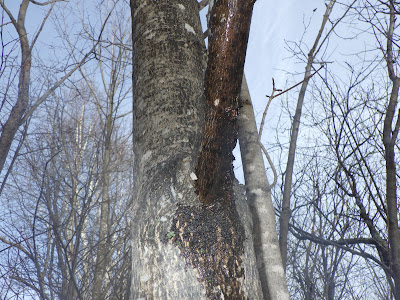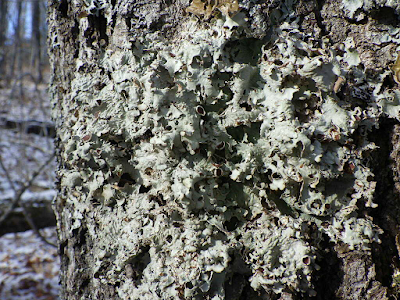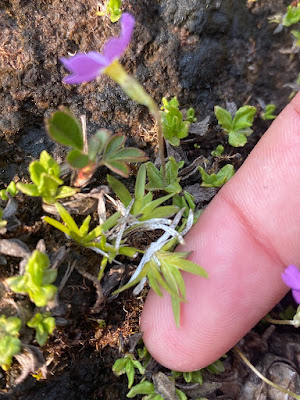Sap is Flowing
Today David, Brie, Logan and I drove to the end of the driveway and snowshoed around for a while, collecting birch bark for winter survival class. From a distance I noticed one of the large maple trees had a streak of darker bark running up and down it. As I walked closer, I saw it was because that part of the trunk was wet. I gave it a little taste and it was nice and sweet. Yep, the sap of at least a few of the sugar maples is flowing, in January! Quite a surprise, usually in this area the maple tapping season begins in early April and lasts for a couple of weeks. But, with such warm weather today and the past week or so, I guess it isn't so surprising.
This is quite the phenological event. So far it's been an exceptionally warm winter with little snow, lots of things seem to be happening "out of season" this year. Snowshoe hares had white coats with no snow to camouflage them for quite a while, (each day there is less and less snow, maybe they'll be mismatched with the environment again soon) I saw a garter snake out and about in mid-November, the chipmunks were also pretty late to start hibernating, and I could list many other examples of unique phenology this winter. Today it reached a high of 45 degrees, it looks like this heatwave is supposed to continue for quite a few more days. I wouldn't be surprised if some trees start budding out.
With all that said, winter is far from over. I'm guessing that temperatures will start to drop pretty soon and hopefully we'll get some more snowstorms. Short spells of warmer weather are nothing out of the ordinary this time of year. But, this year has been unique in having so few cold days and having such long and hot warm spells. It will be interesting to continue to make observations like today throughout the rest of the season, and try and discern what ecological impacts this unusual winter will have in the coming weeks, months, and years. For example, it seems like there were a lot more snowshoe hare kills this fall/early winter being they couldn't hide. I would imagine that their population will decrease and their predators will increase (great news for the wolves and lynx). But, on the other hand, its been a very easy winter with plenty of food available because of the nearly absent snow, so I would guess that there will be less winter die off from starvation. There are so many factors to consider and so many possible ways that all relationships could be impacted. I would only expect seasonally weird events like this to become more of the norm as climate change continues to escalate. How will species in this area and others adapt to these continued changes?
But, lets turn back to the running sap, how does it happen. During the fall, as the tree is going dormant, it stores most of its carbohydrates in the roots for the winter, the only place where the tree is really metabolically active at this time. But, come spring, the tree needs those carbohydrates to flow up to the leaves as the buds begin to burst and the tree needs the energy stored in those sugars. Similar to how our blood carries sugars and nutrients to our cells, the sap carries them to the plants cells.
Temperature is the main factor that gets the sap running. It's actually a pretty complex system to move this sap, that isn't even fully understood by researchers. But, the general idea is that warming temperatures increase pressure in the vascular tissue and it stars flowing, it will flow out of the tree if there is a deep enough wound, maybe caused by a woodpecker, a squirrel, or a spile. Warm temperatures are just half of the equation, freezing is also required. As the temperatures rise in the day and fall below freezing at night, the liquids in the sap expand and retract, essentially creating a pump of sorts. That's why the tapping season is so ephemeral and temperamental, it requires just the right balance of temperature swings. Sometimes these conditions last for a while and sometimes for only a week or two.
I wonder what the tapping season will look like this year, perhaps some people have already started doing some. What will the weather be like at the "normal" season for tapping? Long term, how will the climate shift affect the tapping season. I've heard climate change referred to as global weirding, taking into account that weird events like this have happened far more frequently and with higher intensities. When will it no longer be considered weird for the phenological events discussed above to happen when they do?



Comments
Post a Comment